
Hildegard of Bingen, also known as Saint Hildegard and the Sibyl of the Rhine, was a German Benedictine abbess, writer, composer, philosopher, Christian mystic, visionary, and polymath of the High Middle Ages. She is one of the best-known composers of sacred monophony, as well as the most recorded in modern history. She has been considered by many in Europe to be the founder of scientific natural history in Germany.

Therese of Lisieux, born Marie Françoise-Thérèse Martin, also known as Saint Therese of the Child Jesus and the Holy Face, was a French Catholic Discalced Carmelite nun who is widely venerated in modern times. She is popularly known as "The Little Flower of Jesus", or simply "The Little Flower.”
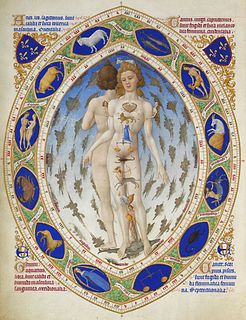
Medieval medicine in Western Europe was composed of a mixture of pseudoscientific ideas from antiquity. In the Early Middle Ages, following the fall of the Western Roman Empire, standard medical knowledge was based chiefly upon surviving Greek and Roman texts, preserved in monasteries and elsewhere. Medieval medicine is widely misunderstood, thought of as a uniform attitude composed of placing hopes in the church and God to heal all sicknesses, while sickness itself exists as a product of destiny, sin, and astral influences as physical causes. On the other hand, medieval medicine, especially in the second half of the medieval period, became a formal body of theoretical knowledge and was institutionalized in the universities. Medieval medicine attributed illnesses and disease, not to sinful behaviour, but to natural causes, and sin was only connected to illness in a more general sense of the view that disease manifested in humanity as a result of its fallen state from God. Medieval medicine also recognized that illnesses spread from person to person, that certain lifestyles may cause ill health, and some people have a greater predisposition towards bad health than others.
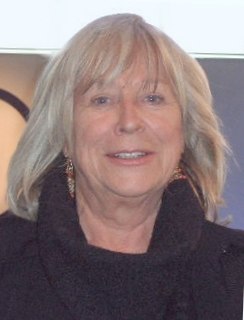
Margarethe von Trotta is a German film director who has been referred to as a "leading force" of the New German Cinema movement. Von Trotta's extensive body of work has won awards internationally. She was married to and collaborated with director Volker Schlöndorff. Although they made a successful team, von Trotta felt she was seen as secondary to Schlöndorff. Subsequently, she established a solo career for herself and became "Germany's foremost female film director, who has offered the most sustained and successful female variant of Autorenkino in postwar German film history". Certain aspects of von Trotta's work have been compared to Ingmar Bergman's features from the 1960s and 1970s.
Viriditas is a word meaning vitality, fecundity, lushness, verdure, or growth. It is particularly associated with abbess Hildegard von Bingen, who used it to refer to or symbolize spiritual and physical health, often as a reflection of the Divine Word or as an aspect of the divine nature.
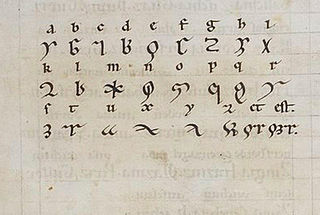
A lingua ignota was described by the 12th century abbess of Rupertsberg, St. Hildegard of Bingen, OSB, who apparently used it for mystical purposes. It consists of vocabulary with no known grammar; the only known text is individual words embedded in Latin. To write it, Hildegard used an alphabet of 23 letters denominated litterae ignotae.
Ordo Virtutum is an allegorical morality play, or sacred music drama, by St. Hildegard, composed c. 1151, during the construction and relocation of her Abbey at Rupertsberg. It is the earliest morality play by more than a century, and the only Medieval musical drama to survive with an attribution for both the text and the music.

Seventh-day Adventists believe church co-founder Ellen G. White (1827–1915) was inspired by God as a prophet, today understood as a manifestation of the New Testament "gift of prophecy," as described in the official beliefs of the church. Her works are officially considered to hold a secondary role to the Bible, but in practice there is wide variation among Adventists as to exactly how much authority should be attributed to her writings. With understanding she claimed was received in visions, White made administrative decisions and gave personal messages of encouragement or rebuke to church members. Seventh-day Adventists believe that only the Bible is sufficient for forming doctrines and beliefs, a position Ellen White supported by statements inclusive of, "the Bible, and the Bible alone, is our rule of faith".
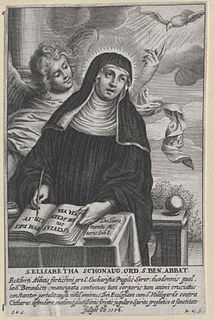
Elisabeth of Schönau was a German Benedictine visionary. She was an abbess at the Schönau Abbey in the Duchy of Nassau, and experienced numerous religious visions, for which she became widely sought after by many powerful men as far away as France and England.
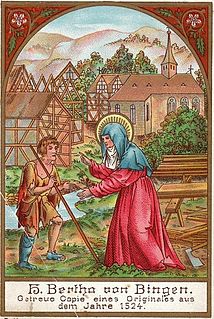
Saint Bertha of Bingen was the mother of Rupert of Bingen. Her biography was written, and subsequently her cult popularized, by Hildegard of Bingen, who lived in the same region, about four hundred years later. Bertha and Rupert share a feast day on 15 May.
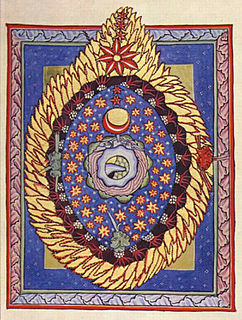
Scivias is an illustrated work by Hildegard von Bingen, completed in 1151 or 1152, describing 26 religious visions she experienced. It is the first of three works that she wrote describing her visions, the others being Liber vitae meritorum and De operatione Dei. The title comes from the Latin phrase "Sci vias Domini". The book is illustrated by 35 miniature illustrations, more than that are included in her two later books of visions.
This is a bibliography of Hildegard of Bingen's works.

This is a discography of Hildegard of Bingen's musical works.
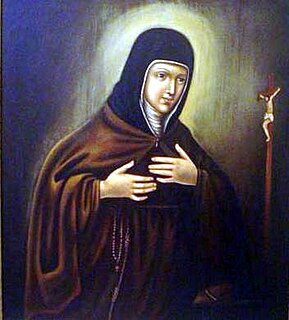
Camilla Battista da Varano O.S.C.,, from Camerino, Italy, was an Italian princess and a Poor Clare nun and abbess. She is venerated as a saint in the Catholic Church.
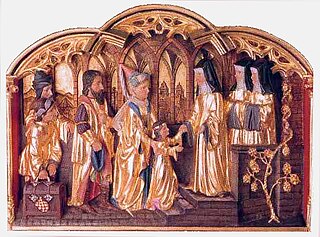
Countess Jutta von Sponheim was the youngest of four noblewomen who were born into affluent surroundings in what is currently the Rhineland-Palatinate. She was the daughter of Count Stephen of Spanheim.

Vision is a 2009 German film directed by Margarethe von Trotta.
Prelest, also known as: spiritual delusion, spiritual deception, delusion, illusion, is a Orthodox Christian term referring to, according to Holy Fathers of Orthodox Church, a false spiritual state, a spiritual illness, "a wounding of human nature by falsehood".
Medieval women's mysticism was "a succession of insights and revelations about God that gradually transformed the recipient" according to historian Elizabeth Petroff of Oxford University in her 1994 book, Body and Soul. The word "mysticism" has its origin in ancient Greece where individuals called the mystae participated in mystery religions. The life of a medieval woman mystic was spent seeking unity with God in a series of stages. The mystical life of a medieval woman began with a purge of the spirit in which she released herself from earthly indulgences and attachments. In a state of contrition the medieval woman mystic faced suffering because of her past sins, and the mercy of God was revealed to her through penitence. Mystics sought to imitate the suffering of Christ in order to gain an understanding through experience. During the compassion stage of suffering, the pain experienced by the medieval woman mystic "revealed the believer's love of Christ, fostered unity with Christ and the world, and began to draw the believer beyond the physical Jesus who suffered on the Cross to understand the immensity of the love that motivated Christ in the world to suffer on humanity's behalf". Medieval women mystics experienced visions during what medieval historians refer to as the Illuminative stage of their lives that contained instructions from God and would communicate their revelations in written form.
Saints Maximos and Domadious are saints in the Coptic Orthodox Church.
In the Green is a one-act musical with a book, music, and lyrics by Grace McLean. The show tells the story of medieval composer, mystic, scientist, and Catholic saint Hildegard von Bingen “on her path to sainthood from childhood,” primarily depicting the thirty years she spent locked up in a cell with her mentor, the anchoress Jutta von Sponheim.












